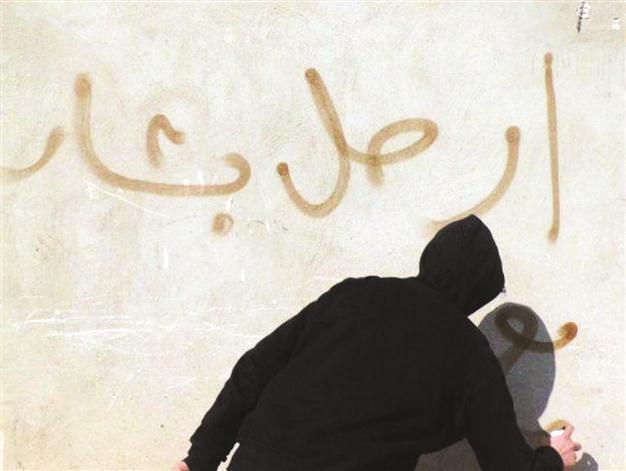Worlds apart within 20 km: Douma to Damascus
Hande Aşık DOUMA

A man is writing ‘Go Away Bashar’ on a wall in Douma, near Damascus, Syria on Feb 4. A Syrian government security forces soldier (inset) stands at a checkpoint as he checks the identity cards of Syrian citizens at one of several suburbs of Damascus that saw heavy fighting between troops and defectors before al-Assad’s forces retook the areas in late Jan. AP photo
The presence of the army bothers us. Some soldiers are nice but the others are very rude. They disrupt our daily life. We can’t go to work, our children can’t go to school. I am scared that my family will be caught in cross-fire. These are the words of an assistant engineer who does not want to be named and complains about the presence of army check points on the main street of Douma. In this town, which feels more like a suburb of Damascus than a separate city, the Syrian army is an omnipresent truth of life. They are there to stay.Douma was the scene of anti-government protests as early as April - less than a month after the protests started in Daraa on March 18th. Today, it is seen by many as the opposition stronghold that is closest to Damascus. Connected to the Syrian capital by an express highway, it is only 20 minutes away from Damascus city center. However, the mood could not be more different.
Under state or emergency
While downtown Damascus radiates a sense of normality, Douma feels like a town under a state of emergency. Vehicles enter through check points and every passenger goes through an ID control to make sure that they are not on the “wanted” list. As we drive into the city, a huge poster of Bashar al-Assad on the city council building welcomes us. The building has been attacked numerous times. There is a gaping hole in the upper right corner of the poster. We were told that it had been burned through with an RPG.
The soldiers that come to surround us at that roundabout quickly take us to a house they say was raided earlier that morning. We pass through the industrial zone and arrive in an extremely quiet, run-down neighborhood. According to the soldiers, the two-floor building was used as a safe house by the armed opposition. There is a metal door on the floor of the main room towards the very back. Metal stairs descend into a small underground room that was reportedly used to store weapons and treat the wounded. The weapons are mostly AK-47s and RPGs.
A woman and her 5 children stare at us from a distance as we leave the neighborhood. Back in the town’s main shopping street, a young woman tells us that she misses the sense of normality in her life. “We are always terrified. We have no sense of security. I am even afraid of my neighbors. I hope to return to my old life as soon as possible. This situation has been going on for a surprisingly long time,” she says.
Right next to Douma is another small town called Harasta. We drive through streets where most shops have their shutters down. At the entrance of many streets there is either a check point or a military barrier built up of dirt-filled sacks. Syrian soldiers – some of whom seem to be younger than 20 – have devised ingenious ways to facilitate what appears to be a long wait. Harasta, which hosts the infamous Air Force Intelligence headquarters, is another place where the military is likely to stay. The rubble of a children’s park and the buildings full of bullet holes are signs of the proximity of clashes. The adults, some of whom express disbelief about what their country has come to, run away from the cameras. The children, who do not realize that having journalists in their neighborhood is not an ordinary development, smile and wave at us.
















